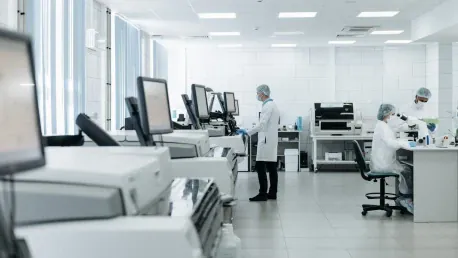BiomedParse, a revolutionary biomedical foundation model for image analysis, is transforming the landscape of biomedical image analysis with groundbreaking precision and scalability. Developed by researchers at Microsoft Research, Providence Genomics, Earle A. Chiles Research Institute, Providence Cancer Institute, and the Paul G. Allen School of Computer Science and Engineering, University of Washington, this model marks a significant leap forward from traditional methods by addressing key inefficiencies and limitations.
Traditional Challenges in Biomedical Image Analysis
Segregation of Image Segmentation and Object Detection/Recognition Tasks
Biomedical image analysis is crucial for understanding complex physiological and anatomical structures, yet traditional methodologies have inherent limitations. Traditional approaches often segregate image segmentation and object detection/recognition tasks. Image segmentation involves dividing an image to distinguish between the background and the object of interest, while object detection/recognition tasks consist of identifying the objects and their locations in the given image. This segregation restricts the opportunity for joint learning, limiting both efficiency and accuracy. As a result, scientists and clinicians face delays in processing and analyzing biomedical images, potentially impacting diagnostic accuracy and research outcomes. The separation of segmentation and detection/recognition not only hampers the utilization of shared information between tasks but also demands more computational resources, reducing overall system performance.
Limitations of User-Drawn Bounding Boxes
Segmentation usually requires user-drawn bounding boxes to locate objects, posing several challenges. Firstly, it demands expert domain knowledge to accurately identify objects, meaning that only highly trained professionals can conduct this work effectively. Secondly, rectangular bounding boxes poorly represent irregularly shaped objects, which are common in biomedical imagery, leading to suboptimal segmentation results. Finally, scalability issues arise in images with numerous objects, such as cells in whole-slide pathology images, making manual outlining impractical. Traditional methods focus solely on segmentation, often neglecting semantic information from related tasks, such as object types or metadata, thus reducing overall segmentation quality. Therefore, innovative solutions like BiomedParse are crucial to overcoming these obstacles and enhancing the accuracy and efficiency of biomedical image analysis.
Development and Capabilities of BiomedParse
Creation of BiomedParseData
The researchers’ goal was to create a model capable of joint segmentation, detection, and recognition. Consequently, they developed a vast resource named BiomedParseData, combining 45 different biomedical segmentation datasets. Semantic information from these datasets—typically noisy and inconsistent—was meticulously consolidated into a unified biomedical object ontology using GPT-4 and manual review processes. The resultant ontology comprised three main categories (histology, organ, and abnormality), 15 meta-object types, and 82 specific object types. By utilizing GPT-4 for synonymous descriptions of semantic labels, the dataset expanded to an extensive 6.8 million image–mask–description triples, providing a rich repository of information for training BiomedParse.
Modular Design and Training
BiomedParse employs a modular design inspired by the SEEM (Segment Everything Everywhere All at Once) architecture, featuring an image encoder, a text encoder, a mask decoder, and a meta-object classifier for joint training with semantic information. Unlike state-of-the-art methods like MedSAM, which use bounding boxes, BiomedParse employs text prompts for segmentation and recognition, significantly enhancing its scalability. The model’s architecture allows for the integration of image and text data, facilitating more accurate and context-aware segmentation and recognition. This innovative approach enables BiomedParse to outperform traditional methods, particularly in handling irregularly shaped objects and providing comprehensive annotations without relying on user-drawn bounding boxes. By seamlessly combining segmentation, detection, and recognition tasks, BiomedParse sets a new benchmark for biomedical image analysis.
Performance Across Imaging Modalities
Validation Across Nine Imaging Modalities
BiomedParse’s performance was extensively validated across nine imaging modalities, demonstrating its versatility and robustness in various biomedical imaging contexts. These modalities include:
- Pathology
- Computed Tomography (CT)
- Magnetic Resonance Imaging (MRI)
- Ultrasound
- X-ray
- Fluorescence Microscopy
- Electron Microscopy
- Phase-Contrast Microscopy
- Brightfield Microscopy
The researchers evaluated BiomedParse’s performance using a diverse test set encompassing 102,855 instances across these nine modalities. By consistently attaining superior Dice scores compared to other segmentation models, such as the Segment Anything Model (SAM) and Medical SAM (MedSAM), BiomedParse proved its efficacy and precision across different imaging techniques.
Comparative Analysis with Other Models
In a comparative analysis with state-of-the-art models, BiomedParse achieved state-of-the-art results across image segmentation, object detection, and recognition tasks. Even when provided oracle bounding boxes—highly accurate representations of object boundaries—MedSAM could not match BiomedParse’s performance. When evaluated in more realistic situations using bounding boxes generated by Grounding DINO, BiomedParse’s superiority was more pronounced, particularly in challenging modalities like pathology and CT. This underscores BiomedParse’s distinct advantage in segmenting irregularly shaped objects where traditional bounding box-based methods, such as MedSAM, struggle. This remarkable performance reaffirms BiomedParse’s potential to revolutionize biomedical image analysis, providing precise and scalable solutions that can adapt to various imaging modalities and clinical applications.
Semantic and Object Recognition
Textual Prompts for Enhanced Performance
Using textual prompts like “glandular structure in colon pathology,” BiomedParse achieved a median Dice score of 0.942, a significant improvement over SAM and MedSAM, which scored below 0.75 without bounding boxes. The enhancement in performance of BiomedParse correlated strongly with object irregularity, demonstrating its capability to manage complex shapes effectively. By leveraging textual prompts for segmentation and recognition, BiomedParse can bypass the limitations of traditional methods and improve the accuracy and efficiency of biomedical image analysis. This innovative approach enables the model to handle a diverse range of objects and structures, making it a valuable tool for researchers and clinicians in various biomedical fields.
Real-World Validation
In terms of object recognition, BiomedParse not only identified objects but also labeled all objects in an image without the need for user-generated prompts. Real-world validation further affirmed BiomedParse’s proficiency; it successfully annotated immune and cancer cells in pathology slides, closely matching annotations provided by human pathologists. While pathologists might generate coarse-grained annotations, BiomedParse offers precise and comprehensive labeling. This precision in labeling not only supports diagnostic accuracy but also reduces the manual workload for clinicians, allowing them to focus on more complex tasks that require human expertise. By delivering accurate and scalable annotations, BiomedParse enhances both research and clinical workflows, ultimately improving patient outcomes.
Limitations and Future Directions
Current Limitations
Despite its groundbreaking capabilities, BiomedParse has certain limitations that need to be addressed. One significant limitation is its requirement for post-processing to distinguish individual object instances, which can add complexity and time to the analysis process. Furthermore, BiomedParse lacks conversational capacities, which could enhance user interaction and tailor the model’s responses to specific queries. Another limitation is its reduction of three-dimensional (3D) modalities to two-dimensional (2D) image slices. This reduction potentially misses out on critical spatiotemporal information that is essential for a comprehensive understanding of certain biomedical phenomena. Addressing these limitations is crucial for further enhancing the efficiency and applicability of BiomedParse in various biomedical contexts.
Pathways for Future Enhancements
BiomedParse is a groundbreaking biomedical foundation model for image analysis, revolutionizing the field with its exceptional precision and scalability. This innovative model was developed by a team of researchers from Microsoft Research, Providence Genomics, Earle A. Chiles Research Institute, Providence Cancer Institute, and the Paul G. Allen School of Computer Science and Engineering at the University of Washington.
BiomedParse represents a significant advancement over traditional image analysis methods, which often suffer from inefficiencies and limitations. These older methods typically require more manual input and lack the ability to effectively scale, resulting in inconsistent results and slower processing times. By contrast, BiomedParse leverages advanced machine learning techniques to analyze biomedical images with an unprecedented level of accuracy and efficiency.
This model can handle vast amounts of data, making it ideal for large-scale biomedical research and clinical applications. It can identify patterns and details in images that were previously missed, leading to better diagnostic tools and ultimately improving patient outcomes. The collaboration among the aforementioned institutions has resulted in a tool that pushes the boundaries of what is possible in biomedical image analysis. As a result, BiomedParse is expected to become a cornerstone technology in the field, setting new standards and opening up new possibilities for researchers and clinicians alike.









